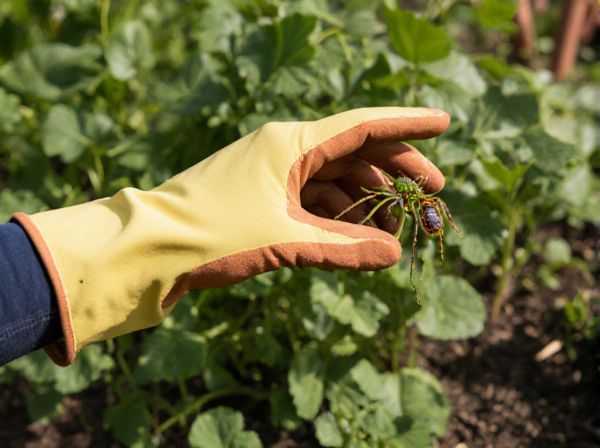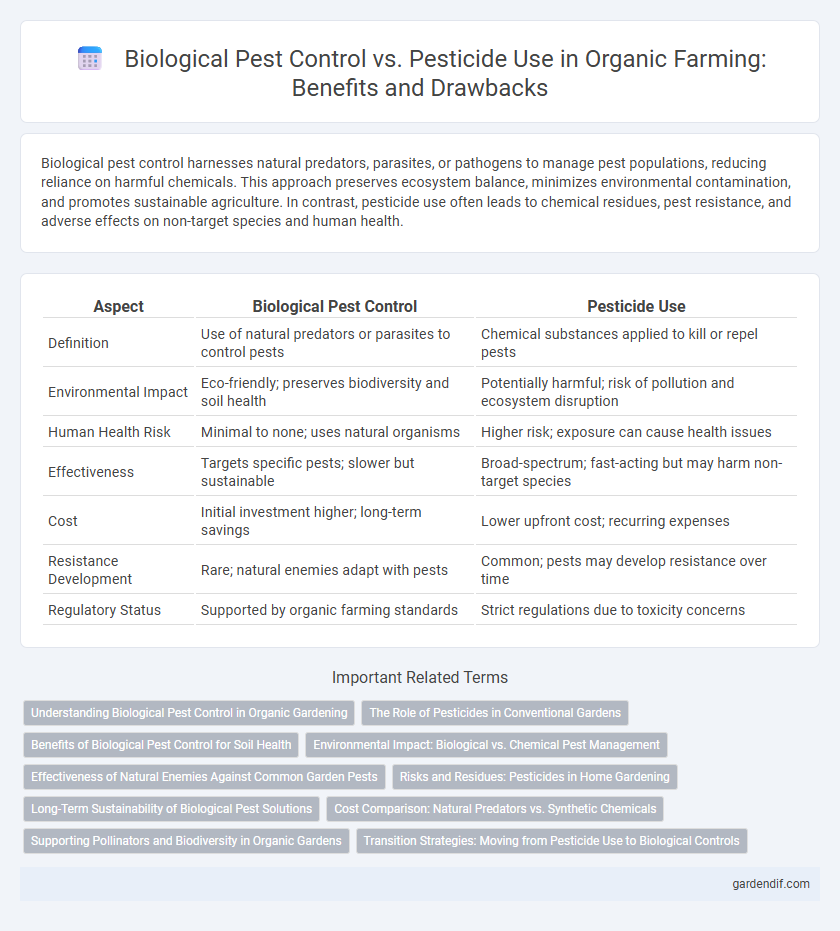
Biological pest control vs pesticide use Illustration
Biological pest control harnesses natural predators, parasites, or pathogens to manage pest populations, reducing reliance on harmful chemicals. This approach preserves ecosystem balance, minimizes environmental contamination, and promotes sustainable agriculture. In contrast, pesticide use often leads to chemical residues, pest resistance, and adverse effects on non-target species and human health.
Table of Comparison
| Aspect | Biological Pest Control | Pesticide Use |
|---|---|---|
| Definition | Use of natural predators or parasites to control pests | Chemical substances applied to kill or repel pests |
| Environmental Impact | Eco-friendly; preserves biodiversity and soil health | Potentially harmful; risk of pollution and ecosystem disruption |
| Human Health Risk | Minimal to none; uses natural organisms | Higher risk; exposure can cause health issues |
| Effectiveness | Targets specific pests; slower but sustainable | Broad-spectrum; fast-acting but may harm non-target species |
| Cost | Initial investment higher; long-term savings | Lower upfront cost; recurring expenses |
| Resistance Development | Rare; natural enemies adapt with pests | Common; pests may develop resistance over time |
| Regulatory Status | Supported by organic farming standards | Strict regulations due to toxicity concerns |
Understanding Biological Pest Control in Organic Gardening
Biological pest control in organic gardening involves using natural predators, parasites, or pathogens to manage pest populations, reducing reliance on chemical pesticides. This method promotes ecological balance and enhances soil health by preserving beneficial organisms and minimizing toxic residues. Employing biological control agents like ladybugs, nematodes, and Bacillus thuringiensis supports sustainable pest management while safeguarding environmental and human health.
The Role of Pesticides in Conventional Gardens
Pesticides in conventional gardens are primarily used to eliminate pests quickly and protect crop yields, often resulting in chemical residues in soil and plants. This approach can disrupt natural ecosystems by harming beneficial insects and leading to pest resistance over time. Biological pest control offers a sustainable alternative by leveraging natural predators and parasites to maintain pest populations without harmful chemical inputs.
Benefits of Biological Pest Control for Soil Health
Biological pest control enhances soil health by promoting biodiversity and maintaining balanced microbial communities, which improve nutrient cycling and soil structure. Unlike chemical pesticides, biological agents do not leave harmful residues, preventing soil contamination and preserving beneficial organisms like earthworms and mycorrhizal fungi. This sustainable approach supports long-term soil fertility and ecosystem resilience in organic farming systems.
Environmental Impact: Biological vs. Chemical Pest Management
Biological pest control utilizes natural predators and parasites to manage pest populations, significantly reducing chemical runoff and soil contamination compared to synthetic pesticides. Chemical pest management often leads to the disruption of local ecosystems, harming non-target species and contributing to pesticide resistance. Adopting biological methods enhances biodiversity and promotes long-term agricultural sustainability by minimizing environmental hazards.
Effectiveness of Natural Enemies Against Common Garden Pests
Natural enemies such as ladybugs, parasitic wasps, and predatory mites effectively reduce populations of aphids, caterpillars, and spider mites in organic gardens. Studies show biological pest control maintains pest populations below damaging thresholds without harming beneficial insects or causing chemical residues. Compared to synthetic pesticides, natural enemies provide sustainable, long-term pest suppression while promoting ecological balance and soil health.
Risks and Residues: Pesticides in Home Gardening
Biological pest control reduces health risks by minimizing chemical residues commonly found in pesticide-treated home gardens, which can contaminate soil and water. Pesticide use often leads to persistent toxic residues that pose hazards to pollinators, beneficial insects, and human health. Employing natural predators and biopesticides sustainably manages pests while preserving ecological balance and reducing environmental contamination.
Long-Term Sustainability of Biological Pest Solutions
Biological pest control promotes long-term sustainability by utilizing natural predators and parasites, reducing the need for harmful chemical pesticides that can lead to resistance and environmental damage. This method enhances ecosystem balance, preserving beneficial insect populations and soil health critical for ongoing agricultural productivity. Over time, biological pest solutions reduce dependency on synthetic inputs, contributing to resilient, environmentally friendly farming practices.
Cost Comparison: Natural Predators vs. Synthetic Chemicals
Biological pest control using natural predators often results in lower long-term costs compared to synthetic chemicals, as it reduces the need for repeated pesticide applications and minimizes environmental cleanup expenses. While initial investment in establishing predator populations may be higher, savings accrue through sustained pest suppression and decreased resistance development. In contrast, pesticide use typically demands ongoing purchases and application costs, alongside potential financial risks from crop damage due to pesticide resistance and regulatory restrictions.
Supporting Pollinators and Biodiversity in Organic Gardens
Biological pest control in organic gardens enhances pollinator health by reducing chemical exposure that pesticides commonly cause, thus preserving vital insect populations. Beneficial insects like ladybugs and parasitic wasps naturally manage pest populations while promoting biodiversity and ecosystem resilience. This approach supports sustainable garden ecosystems by maintaining balance and reducing negative environmental impacts associated with synthetic pesticides.
Transition Strategies: Moving from Pesticide Use to Biological Controls
Transitioning from pesticide use to biological pest control involves integrating beneficial organisms such as predatory insects, parasitoids, or microbial agents to naturally manage pest populations. Implementing crop rotation, habitat diversification, and monitoring pest thresholds supports the gradual reduction of chemical pesticide reliance while maintaining crop health. Adoption of these biological strategies promotes sustainable agriculture by enhancing ecosystem resilience and minimizing environmental toxicity.
Biological pest control vs pesticide use Infographic

 gardendif.com
gardendif.com